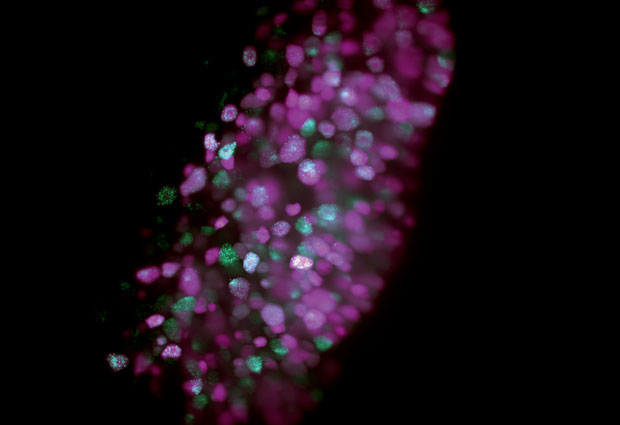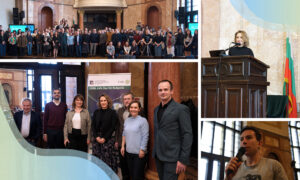
Bridging excellence: EMBL and Stanford’s Alliance
EMBL Senior Scientist Lars Steinmetz, who directs the Life Science Alliance, reflects on the progress made since the launch of the EMBL and Stanford initiative

By Lars Steinmetz
At our inaugural event, participants from EMBL, Stanford, and many other institutes had the opportunity to discuss exciting scientific developments, interact with leading researchers and form new transatlantic collaborations. Indeed, enabling this kind of scientific exchange was one of the main reasons motivating me to initiate the Life Science Alliance – 18 months on and I am glad to see how much it has grown. We have seen staff travel between the two sites, started the next cycle of scientific meetings and launched a website to showcase our vision and achievements. In the near future I expect the Life Science Alliance to grow further and provide more support for the most promising scientific ideas that connect researchers at Stanford and EMBL.
Close connections
After completing my PhD in 2001, I was given the terrific opportunity to start my own research group at EMBL while remaining affiliated with Stanford, first as a visiting group leader and later as Professor of Genetics and Co-Director of the Stanford Genome Technology Center. This was a great opportunity for me – for one, because I was raised in both Europe and the US and feel at home on both continents, but more importantly because it provided me access to unique scientific infrastructure from which my career has benefitted tremendously ever since. I have not only been exposed to all kinds of cutting edge technologies but have also been able to work with some of the brightest minds on both continents, immersing me into diverse fields of research and technology development. This setting enabled me to make discoveries that would otherwise have taken much longer to realise.
I expect the Life Science Alliance to grow and provide more support for the most promising scientific ideas that connect researchers at Stanford and EMBL
By initiating the Life Science Alliance, I want to make similar opportunities available to other researchers on both sides of the Atlantic. I believe that Stanford and EMBL have very complementary strengths: EMBL is a leader in fundamental research, and computational biology, while Stanford is particularly renowned for its clinical research, bioengineering, and entrepreneurial achievements. In my opinion, combining these strengths in a strategic research alliance makes total sense and will result in new discoveries and technological innovations that answer fundamental biological questions and address unmet clinical needs.
Strategically, the Life Science Alliance is constructed on three main pillars:
(1) enabling unbureaucratic exchange across all career levels, (2) providing access to excellent training resources and core facilities, and (3) delivering joint scientific meetings that alternate between the two sites. These principles were captured in an official Memorandum of Understanding that was signed by both institutes in 2014. The Life Science Alliance was then formally launched by Iain Mattaj, EMBL Director General, and Lloyd Minor, Dean of the Stanford School of Medicine, at a joint conference on personalised health in 2015, a meeting with about 200 participants that will be repeated at Stanford in early November. An inspiring meeting focusing on structural biology also took place in Stanford last summer.
Indeed, scientific exchange is a core aspect of the Life Science Alliance
Exchange at heart
The Life Science Alliance provides an exciting opportunity for postdocs and students to form networks and collaborations that will benefit them for the rest of their careers, whether in Europe or the US, in academia or the private sector. They have the chance to get a taste of how science is done on another continent whose research environment they may not know. I can, for example, imagine EMBL graduate students using the Life Science Alliance to prepare for a postdoc in Stanford, and vice versa. In this respect, EMBL group leader Judith Zaugg provides an example of what we want to achieve. Judith did her PhD at EMBL-EBI in Hinxton before embarking on a postdoc at Stanford and is now a group leader back at EMBL in Heidelberg, where she continues to collaborate with her Stanford network.
Indeed, scientific exchange is a core aspect of the Life Science Alliance. We have seen researchers from both institutions co-author books and papers, while others have spent sabbaticals or directly work on joint projects. Through the Life Science Alliance we hope to increase the support for this kind of exchange of staff at all levels, including graduate students, postdocs and group leaders. A steering committee that meets twice a year and comprises senior scientists from both institutes and cover the three primary fields of research in which the partnership is currently most active: genome biology, biological imaging and structural biology. I envision the Life Science Alliance expanding to other areas in the future. I encourage any EMBL scientists interested in extending the concept to their unit to contact me directly.
To find out more visit our Life Science Alliance website.


